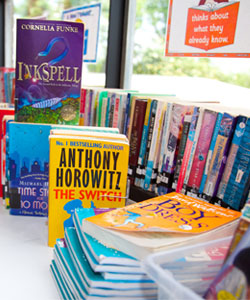English

A child’s ability to communicate is vital to all aspects of their learning, so English learning cuts across all areas of the curriculum. We also plan for literacy-specific learning every day in school, in line with the expectations of the National Curriculum.
The aim is for all Fairlawn children to be confident and enthusiastic speakers, readers and writers, so we provide a broad range of daily activities for children to develop and apply their speaking, listening, reading and writing skills. Included in this provision are opportunities for public-speaking and drama activities and reading and writing in different styles and for different purposes.
Reading
At Fairlawn, we recognise the importance of reading as a lifelong skill. In our journey towards being lifelong readers, we seek to foster a love of reading through our two-stage reading approach where we Learn to Read, then we Read to Learn.
We have put together a short video about the importance of fostering a love of reading, and how you can support your child at home:
Learn to Read
Learning to read is a priority at Fairlawn Primary School. We believe that for all our children to become fluent readers and writers, phonics must be taught through a systematic and structured phonics programme.
To help us to learn to read, we practice phonics every day in EYFS and Key Stage 1 using the Systematic Synthetic Phonics (SSP) programme – Little Wandle Letters and Sounds. In phonics, we teach children that the letters of the alphabet represent a different sound, that these can be used in a variety of combinations and are put together to make words. The children learn to recognise all of the different sounds and combinations that they might see when they are reading or writing. Our phonics teaching starts in Nursery and follows a very specific sequence that allows our children to build on their previous phonic knowledge and master specific phonic strategies as they move through school. As a result, all our children are able to tackle any unfamiliar words that they might discover.
At Fairlawn, we also model these strategies in shared reading and writing both inside and outside of the phonics lesson and across the curriculum. We have a strong focus on the development of language skills for our children because we know that speaking and listening are crucial skills for reading and writing in
all subjects. How we teach phonics and Early Reading (Early Years and KS1)
How we teach phonics and Early Reading (Early Years and KS1)
- In the nursery, children follow the Little Wandle Letters and Sounds Revised ‘Foundations for Phonics’ guidance. The focus is on daily oral blending and language development through high quality stories and rhymes.
- In Reception and Y1, children follow the progression within Little Wandle Letters and Sounds Revised programme. Phonics is taught daily and there is a review session on a Friday.
- Phonics starts in Reception in week 2 to ensure the children make a strong start.
- By the end of Reception, children will have been taught up to the end of phase 4. By the end of Year 1, children will have been taught up to the end of phase 5. Children in year 2 recap any gaps in their phonics knowledge in the autumn term (continued to spring term).
- Reception lessons start at 15 minutes, with daily additional oral blending – increasing quickly to 30 minutes. Y1 and Y2 lessons are 30 minutes long.
Reading practice sessions
- Children across Reception and Year 1 (and beyond if appropriate) apply their phonics knowledge by using a full matched decodable reader in a small group reading practice session.
- These sessions are 15 minutes long and happen three times a week. There are approximately 6 children in a group.
- The sessions follow the model set out in Little Wandle Letters and Sounds Revised.
How do we assess phonic knowledge?
- In Reception, Year 1, and Year 2 at the end of each week there is a review session which recaps the learning. There are also whole review weeks (pre-planned and bespoke review weeks to address gaps identified by the class teacher’s ongoing formative assessment).
- Children identified in Reception and Year 1 as in danger of falling behind are immediately identified and ‘keep up’ sessions are put in place – these sessions follow the Little Wandle Letters and Sounds Revised Keep Up programme.
- In Reception and Year 1, the children are assessed at the end of every half term using the Little Wandle Letters and Sounds Revised assessment tracker.
- Children in Year 1 complete the statutory Phonics Screening Check in the Summer Term. Children who do not meet standard in the Phonics Screening Check in Y1, will complete this in Y2. Support continues to be put in place for these children.
Reading for pleasure – Early Years and KS1
Alongside daily teaching of phonics, reading for pleasure is an important part of our Early Reading offer. We ensure children develop a love of reading and are exposed to a range of interesting and relevant authors. We promote a love of reading in the following ways:
- Teaching of poetry, which includes performing and learning a range of
poems by heart. - Daily storytime.
- Whole class reading storytimes, which include a range of books that are mapped out to ensure children, have a rich reading diet. Vocabulary is explicitly taught and children can learn key phrases in the book.
- Book areas within the classroom, which have a careful selection of books, including books by the focus author.
- Use of Little Wandle Letters and Sounds Revised ‘Foundations for a Love of reading’ stories in nursery.
- Alongside children’s decodable reading books, children also take home a reading for pleasure book each week. In each year group, children will take home a range of book by authors, including some that they have read in class. Year 1 take one fiction and one non-fiction book for pleasure.
If you are a parent and would like more information about how to support your child with phonics at home, please follow this link to find the Reception and Year 1 overview as well as videos of the sound pronunciations, letter formation sheets and other helpful resources.
https://www.littlewandlelettersandsounds.org.uk/resources/for-parents/
Read to Learn
Reading to learn is done through our whole-class teaching of reading and a home reading scheme is operated from reception through to Year 6, whereby children bring home books to share with their families each week. Instilling a love of reading is a really important aim of our reading curriculum, so children do get opportunities throughout the week to read for pleasure.
Writing
Subject Aims:
To develop a community of writers who can write for a range of audiences and purposes to express their feelings, thoughts and passions as they foster a love for writing.
To enable this, children will:
- acquire and use wide and adventurous vocabulary
- develop an understanding of grammar and a knowledge of linguistic conventions for writing
- be taught how to write clearly, accurately and coherently, adapting their language and style in and for a range of contexts
- develop a command of the spoken and written language
End goal
- Children can communicate for a range of purposes through writing
- Transcribe (handwriting and spelling)
- Composition
- Explore and discuss
- Plan
- Write coherently and clearly
- Apply accurate grammar
As a school we have adopted “The Write Stuff” pedagogy to bring clarity to the mechanics of writing.
‘The Write Stuff’ follows a method called ‘Sentence Stacking’ which refers to the fact that sentences are stacked together and organised to engage children with short, intensive moments of learning that they can then immediately apply to their own writing.
This approach makes sure that all of our children are exposed to high quality texts (including novels, picture books and videos), that stimulate quality responses to reading, high quality writing and purposeful speaking and listening opportunities.
Our curriculum ensures that all children have plenty of progressive opportunities to write for different purposes within three overarching genres: Narrative, Expository, and Poetry writing.
Narrative Writing
- Modern Stories
- Traditional Tales
- Legends
- Overcoming Stories
- Adventure Stories
Expository Writing
- Recounts/Journals
- Letters
- Information/Biographies
Poetry
- Free verse
- Rhyming
Our Pedagogy
The Write Stuff is based on two guiding principles; teaching sequences that slide between experience days and sentence stacking lessons. With modelling at the heart of them, the sentence stacking lessons are broken into bite-sized chunks and taught under the structural framework of The Writing Rainbow. Teachers prepare children for writing by modelling the ideas, grammar or techniques of writing.
- Initiate section – a stimulus to capture the children’s imagination and set up a sentence.
- Model section – the teacher close models a sentence that outlines clear writing features and techniques.
- Enable section – the children write their sentence, following the model.
“The Write Stuff” also reinforces grammar through the use of:
- The FANTASTICS which are an acronym that summarise the ideas of writing
- The GRAMARASTICS which are a classroom tool that enables the teacher to drive key grammar concepts
- The BOMBASTICS which are 10 ways of adding literary devices to writing
Impact of our Writing Curriculum
- Support for teachers so that they have a deeper and more flexible knowledge of sentence structure.
- Pupils who understand how to apply sentence scaffolds to their independent writing as they develop their expertise.
- Standards improve because many worked examples are provided across the units of work that extend understanding through a wide range of narrative, expository, and poetry genres and text types.
- Children have a clear view of what high quality writing looks like and their learning is structured clearly and misconceptions dealt with.
- Pupils know how to improve their writing and make it more focused and actionable feedback is provided to guide their learning.
- Children have a concept of how to build, plan, and complete a piece of writing due to narrative maps and non-fiction shapes.
- Teachers have clear pathways of how to guide pupils in weak areas such as cohesion and paragraphs.
Spelling
The children will have weekly spellings sent home to learn. These will consist of words from the National Curriculum statutory word list, as well as words that are commonly misspelt in their writing.
We teach spelling using a variety of techniques:
- Some words will follow a spelling rule – get children to explore these rules.
- For tricky words think about shape, size etc
- Breaking words into sounds (c-a-t)
- Breaking words into syllables (re-mem-ber)
- Break it into affixes (dis +satisfy)
- Use a mnemonic (necessary – one collar, two sleeves)
- Refer to a word in the same family (muscle – muscular) or parts of the word they already know.
- Say it as sounds/in a funny way (Wed-nes-day)
- Words within words (Parliament – I AM parliament)
- Refer to etymology (bi+cycle= 2 +wheels)
- Learn by sight (look-cover-write-check)
- Sing it!



